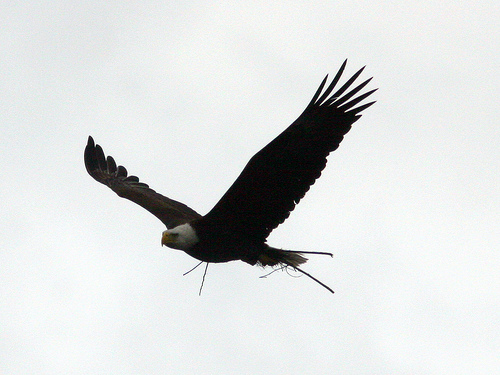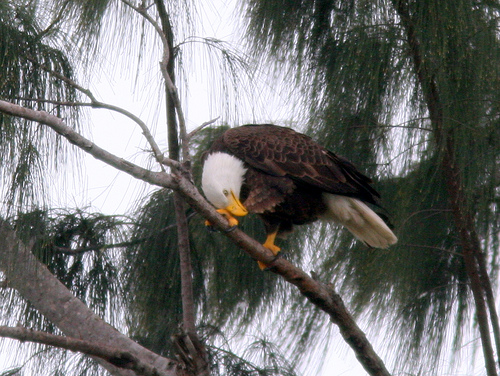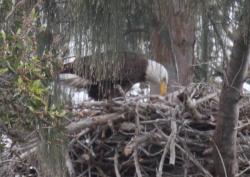Bald Eagles of Broward County, Florida
› ARCHIVED Pembroke Pines OBSERVATIONS & PHOTOS FROM PRIOR NESTING SEASONS
›
ARCHIVED 2009-2010 SEASON Daily Nest Observations & Photos
Sunday, January 24th Hatch day +2
|
Administrator
|
I have updated the Eagle Milestone spreadsheet report, which may be viewed here
Based upon the eagles' change in behavior, I will arbitrarily decree that the first egg hatched (or began to hatch) around noon on Friday, January 22. These changes, first documented by Al at that time, were: increased movement by the incubating adult, along with frequent looking down into the nest, and sitting higher while incubating. Earlier that day, we found the incubating adult resting continuously very low in the nest as observed since incubation began. The next day, January 23, observers reported more movement, almost restlessness on the part of the incubating/brooding adult, which sat higher (more of its body visible above the rim) and kept looking into the nest. Later that day, Jill saw both adults together, looking down into the nest, something we also saw last year just after the chick hatched. Here is my photo taken yesterday, showing the more elevated posture of the incubating female. Note that the full head and part of her back are visible:  This morning there was evidence of a prey item in the nest, something no one has yet reported to happen during incubation of the first egg. No one saw the food being brought in, but we saw the adults tearing at it, eating and possibly reaching down to feed the chick. When we arrived around 9:00 AM this morning, Tom and Trisha were already there. The female was preening in the melaleuca roost tree to the west of the nest:  The male was sitting on the nest, often looking down and at least once appeared to be tearing at a prey item and possibly feeding an unseen eaglet:  The female took flight, flew east behind the nest, then passed in front of the nest, flying west, and landed in the cow pasture to the NW of the nest tree:  Carrying what looked like small sticks and grasses, the female flew back to the nest and joined the male:  Together, they appeared to rearrange nesting material and also tear at a prey item. Then the male flew up to the first roost tree east of the nest and cleaned his bill. Note the brown tip on the right outermost tail feather that distinguishes this male from the female:  The male continued to roost for a short time, then flew to the south and disappeared: 
Ken Schneider
Web site: http://rosyfinch.com Blog: http://rosy-finch.blogspot.com Photos: <http://flickr.com/photos/rosyfinch> |
|
Great review, Ken! Thank you for keeping us posted, especially during the exciting time of the birth of the eaglet hatchling.
|
|
In reply to this post by NewMexiKen
Congratulations, Grandpa
________________________________ From: NewMexiKen [via Bald Eagles of Broward County, Florida] [[hidden email]] Sent: Sunday, January 24, 2010 1:09 PM To: WHITE, Lynda Subject: Sunday, January 24th Hatch day +2 I have updated the Eagle Milestone spreadsheet report, which may be viewed here<http://www.rosyfinch.com/EagleMilestonesSheet.pdf> Based upon the eagles' change in behavior, I will arbitrarily decree that the first egg hatched (or began to hatch) around noon on Friday, January 22. These changes, first documented by Al at that time, were: increased movement by the incubating adult, along with frequent looking down into the nest, and sitting higher while incubating. Earlier that day, we found the incubating adult resting continuously very low in the nest as observed since incubation began. The next day, January 23, observers reported more movement, almost restlessness on the part of the incubating/brooding adult, which sat higher (more of its body visible above the rim) and kept looking into the nest. Later that day, Jill saw both adults together, looking down into the nest, something we also saw last year just after the chick hatched. Here is my photo taken yesterday, showing the more elevated posture of the incubating female. Note that the full head and part of her back are visible: [http://n2.nabble.com/file/n4450000/4300999062_2a048629f2.jpg] This morning there was evidence of a prey item in the nest, something no one has yet reported to happen during incubation of the first egg. No one saw the food being brought in, but we saw the adults tearing at it, eating and possibly reaching down to feed the chick. When we arrived around 9:00 AM this morning, Tom and Trisha were already there. The female was preening in the melaleuca roost tree to the west of the nest: [http://n2.nabble.com/file/n4450000/4300999288_2c406d3e56.jpg] The male was sitting on the nest, often looking down and at least once appeared to be tearing at a prey item and possibly feeding an unseen eaglet: [http://n2.nabble.com/file/n4450000/4300252881_8a6d6464e1.jpg] The female took flight, flew east behind the nest, then passed in front of the nest, flying west, and landed in the cow pasture to the NW of the nest tree: [http://n2.nabble.com/file/n4450000/4300253757_20e80a45de.jpg] Carrying what looked like small sticks and grasses, the female flew back to the nest and joined the male: [http://n2.nabble.com/file/n4450000/4301000774_392c4ac7da.jpg] Together, they appeared to rearrange nesting material and also tear at a prey item. Then the male flew up to the first roost tree east of the nest and cleaned his bill. Note the brown tip on the right outermost tail feather that distinguishes this male from the female: [http://n2.nabble.com/file/n4450000/4300254325_1ef6442b37.jpg] The male continued to roost for a short time, then flew to the south and disappeared: [http://n2.nabble.com/file/n4450000/4301001208_72a9e8bc3b.jpg] Ken Schneider Web site: http://rosyfinch.com Blog: http://blog.rosyfinch.com ________________________________ This email was sent by lwhite<http://n2.nabble.com/user/UserRootNodes.jtp?user=327129> (via Nabble) Your replies will appear at http://n2.nabble.com/Sunday-January-24th-Hatch-day-2-tp4450000p4450000.html To receive all replies by email, subscribe to this discussion<http://n2.nabble.com/subscriptions/Subscribe.jtp?code=bHdoaXRlQGF1ZHVib24ub3JnfDQ0NTAwMDB8Mjc5OTMyNDkz> |
Re: Sunday, January 24th Hatch day +2
|
Administrator
|
In reply to this post by NewMexiKen
Tom Mitchell allowed me to post this shot of the female bringing in nest materials. It is much better than any of mine!

Ken Schneider
Web site: http://rosyfinch.com Blog: http://rosy-finch.blogspot.com Photos: <http://flickr.com/photos/rosyfinch> |
|
Thanks, Ken....for such a great description of the day's activities. It is really exciting anticipating the days ahead when we discover how many eaglets there are in the nest!
I have only one other thing to add to Ken's great description and that is observation that was seen by Tom this morning. He saw both adults on the nest, looking in and moving around and then one flew to one of the tall palms in the median. The eagle seemed to pull at the palm and seemed to be after something in the tree (as a bird, etc). The other adult in the nest was calling loudly and Tom said the next thing he knew, they were switching places, with one heading to the maleleucas. I arrived shortly after this action and observed what looked like an adult on the nest pulling at something in the nest like feedings last yr. This kept up for about 10 min., when at 8:20 the adult in the maleleucas flew to the vacant field and brought back a large talon-full clump of brown straw. It joined the other adult on the nest and they both continued "poking" and watching down in the nest, both standing. Soon one went low with only the head seen and the other flew to the perch in the pine, east of the nest to preen (as they do after feedings) Ken and Mary Lou arrived shortly after and have reported the action from then on. In the span of the 2 plus hours that I was there, both adults were always in sight in the area and twice within that period an adult brought fresh nesting material from the field. The adult seemed to be hunting prey close to the nest in the median and the adult not on the nest never went farther than the maleleucas or the pine near the nest. I definitely agree with Ken that we have enough circumstantial evidence to be quite certain that at least one egg has hatched. It also appears that they are doing an excellent job of tending to the hatchling(s), as we all observed last year. |
|
I watched from 3:00 PM until about 5:15. I had not read Ken's post when I left home this afternoon, and was very glad to read it when I was back at home---I wasn't sure how to describe how confident I was that an adult flew to the nest at 4:39 PM and began to pull at prey and probably feed an eaglet as it did not appear to eating anything itself.
It was less than 10 seconds between the time the feeding adult arrived and the incubating one flew away to the melaleucas. From 3:00 PM until 4:39, the only thing that happened was that the same adult was always on the nest and spent a fair amount of time rearranging things on the nest. I was mooned for lengthy periods of time. I did not see another adult in the area. Mike arrived about 5 minutes after the switch at 4:39. He walked over to take pictures of the eagle in the dead tree. Here's my practice picture of the adult pulling at the prey. 
|
Re: Sunday, January 24th Hatch day +2
|
After Jill left I went over towards the nest. The lone eagle I watched over at the dead tree strand was the female as I checked extensively for the brown tip and there was none. After a while at the nest, around 5:45pm, the female returned and they both moved to the nests rim and looked into the nest. Then the female took over the sitting and the male flew off to the dead tree strand. I followed it and confirmed the brown tip. MF
|
Re: Sunday, January 24th Hatch day +2
|
Administrator
|
Very interesting day. Thanks, Mike, for tracking down and confirming the identity of "Brown-tip." Our ability to distinguish the sex of the adults adds value to behavioral observations.
Ken Schneider
Web site: http://rosyfinch.com Blog: http://rosy-finch.blogspot.com Photos: <http://flickr.com/photos/rosyfinch> |
«
Return to ARCHIVED 2009-2010 SEASON Daily Nest Observations & Photos
|
1 view|%1 views
| Free forum by Nabble | Edit this page |

